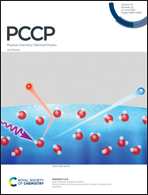Superior mechanical flexibility, lattice thermal conductivity and electron mobility of the hexagonal honeycomb carbon nitride monolayer†
Abstract
Nitrogen is the nearest neighbor element of carbon and, thus, the hexagonal honeycomb carbon nitride monolayer (CxNy), which consists of a covalent network of carbon and nitrogen atoms, usually has attractive physical and chemical properties similar to those in graphene. Here, we systematically investigate the geometric structure, mechanical properties, thermal transport properties, and plasmon excitation of a new phase, labeled C3N2, and make a detailed comparison with other possible CxNy allotropes. All CxNy have a super-high layer modulus and Young's modulus. But compared with the others, C3N2 exhibits excellent mechanical flexibility, and can withstand a relatively high critical strain up to 20% (18%) along the X(Y) direction. Additionally, C3N2 also has excellent thermal and electronic transport properties, with a super-high lattice thermal conductivity of ∼110.9 W m−1 K−1 and electron mobility of ∼1617.52 cm2 V−1 s−1 at 300 K. By performing time-dependent density functional theory (TDDFT), we obtain the optical absorptions of C3N2 and C3N, and meanwhile analyze their Fourier transforms of induced charge densities at some resonant frequencies. The main optical absorption peaks of the C3N2 nanostructure are located in the ultraviolet region, and its plasmon peaks are far higher than those in C3N. Its excellent mechanical and optical properties, the larger electronic band gap, and the higher electron mobility suggest that C3N2 has great potential for application in nanoelectronics and optoelectronics.



 Please wait while we load your content...
Please wait while we load your content...